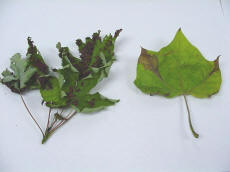|
 Column Column
Leaf problems
By John Fulton
 Send a link to a friend
Send a link to a friend
[May 29, 2014]
We may be running about three weeks
behind normal, but some things are catching up with a vengeance.
Anthracnose leaf fungus is one of them. If you haven’t noticed,
maple tree leaves on the better quality maples, such as red maples
and sugar maples, are browning or drying up in many locations.
|
|
Anthracnose
209_small.JPG) Anthracnose
starts as dead leaf areas between leaf veins, or on the tips of
leaves. When severe enough, leaves will fall. Several of the
infected trees have actually had the leaves turn completely black
already. It is much more noticeable on one side of many trees as
well, due to air movement carrying the disease and drying out
foliage quickly. The good news is that it rarely harms trees. If
enough leaves drop, a new set comes out in 4-6 weeks and we start
all over. The next set of leaves may also get the disease, but they
may not. Infection can continue with weather favorable to the
disease, and when nighttime temperatures stay under 65 degrees.
Treatments when you see the symptoms of this disease are simply
wasted time and money. The old “water and fertilizer routine” is
about the best you can do. Anthracnose
starts as dead leaf areas between leaf veins, or on the tips of
leaves. When severe enough, leaves will fall. Several of the
infected trees have actually had the leaves turn completely black
already. It is much more noticeable on one side of many trees as
well, due to air movement carrying the disease and drying out
foliage quickly. The good news is that it rarely harms trees. If
enough leaves drop, a new set comes out in 4-6 weeks and we start
all over. The next set of leaves may also get the disease, but they
may not. Infection can continue with weather favorable to the
disease, and when nighttime temperatures stay under 65 degrees.
Treatments when you see the symptoms of this disease are simply
wasted time and money. The old “water and fertilizer routine” is
about the best you can do.

Maple leaf bladder gall
_small.JPG) “Soft
maples,” or silver maples are showing symptoms of maple leaf bladder
gall. Same song, different dance. The gall is yellow to red when it
starts out, then turns brown as the year wears on. The cause is a
mite feeding on the leaf. The leaf then swells in response to the
injury and toxins put into the leaf. The “bumps” are actually leaf
tissue. I usually compare it to you getting a mosquito bite. There
is no treatment, since the swellings are actually leaf tissue, and
there is no damage other than the unsightliness. “Soft
maples,” or silver maples are showing symptoms of maple leaf bladder
gall. Same song, different dance. The gall is yellow to red when it
starts out, then turns brown as the year wears on. The cause is a
mite feeding on the leaf. The leaf then swells in response to the
injury and toxins put into the leaf. The “bumps” are actually leaf
tissue. I usually compare it to you getting a mosquito bite. There
is no treatment, since the swellings are actually leaf tissue, and
there is no damage other than the unsightliness.
Apple scab

Apple scab is a disease similar to anthracnose,
and can cause premature leaf drop in apples and crabapples. If
you are on a regular spray schedule for fruit trees, it should
prevent most of the problems. You could also spray crabapples
this way, but you would have to weigh the cost and benefit since
no fruit production is involved.
[to top of second column] |

As a reminder, spray programs for
disease prevention in fruit trees should be applied every 10-14 days
after the bloom period is over. It should be stressed that these are
preventative programs, and not curative. These programs then
continue until roughly two weeks before the fruit is ready to
harvest.
Fire blight on Pear and Apple

Another leaf problem, but a different host set….
There is a large amount of tip dieback in some varieties of pears
and apples, and this is probably fire blight. Look for a shepherd’s
crook at the tip of the affected areas as a clue it is fire blight.
Fire blight is a bacterial disease, therefore there is little chance
for you to treat it. The Bradford ornamental pear is also being
infected, as the new growth is withering. They are rated as
“moderately resistant,” but diseases have a way of changing over
time. This allows them to get around the bred-in resistance.
The common treatment in commercial operations is streptomycin, but
it has to be applied before symptoms appear. Bordeaux mixture can
also help prevent the disease (applied before the infection next
year). Many infections happen at the time of flowering. Also, prune
out disease cankers when dormant.
[By JOHN FULTON, COUNTY EXTENSION
DIRECTOR SERVING LOGAN, MENARD, AND SANGAMON COUNTIES]
 |